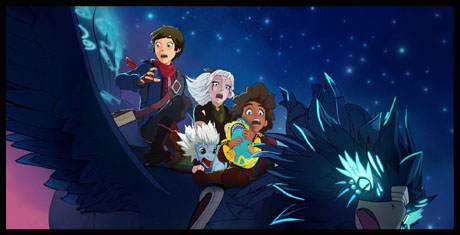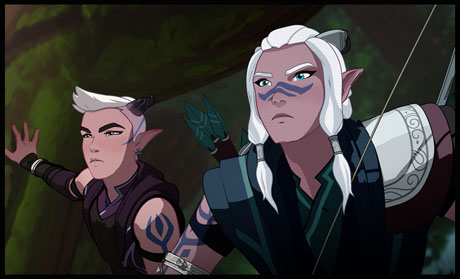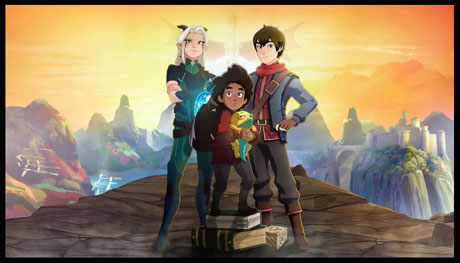
This is a show that, once you begin watching it, you can become hooked, and you don’t want to let go of it. It’s a magical world of elves and dragons and knights and wizards—and a glow toad named “Bait.” It’s also a world of diversity, a mix of age, color, gender, and handicapped characters who overcome their physical limitations. Devious plots abound, with assassination attempts, withheld secrets, and a war brewing on the horizon. And it all takes place in lands of primeval beauty under richly-colored skies.
This is the world of The Dragon Prince, now in its second season on Netflix.
“We have a pretty awesome blend of action and comedy and drama in equal parts. That’s something that is cool,” says co-creator Justin Richmond. “And I think the characters are super fun to watch, and they go in interesting places. The story is twisty and turny, and all those kinds of things.
“And it’s got mystery,” says co-creator Aaron Ehasz. “This season is when you start to see, ‘Oh, wait a minute. There’s some weird stuff that these guys have had in store since the first few minutes of the show that we’re only just starting to get a glimmer at.’ So, we’re excited that this is a show that rewards people who pay attention and care about the details.”
One example is the second-season appearance of Aaravos, a sinister elf who currently resides on the other side of a magic mirror. Aaravos is the one who narrates the prologue in the first episode. His name is identified in the subtitles, and Ehasz and Richmond confirm he is the same character. But can we trust him? After all, Aaravos, as narrator, is the one who informs the viewer that humans have destroyed the King Dragon’s egg—which has galvanized the nation of Xadia to strike back at the human kingdoms. It turns out the egg is intact after all, and it hatches into a baby dragon, Azymondias. This raises the question, if we can’t trust Aaravos, what else in the prologue is Fake History?
“We both love fantasy from way back,” Richmond says on behalf of himself and Ehasz. “I grew up reading fantasy. I’ve said before, my uncle sent me down the dark path of sci-fi and fantasy. He owned a small bookstore. It closed, unfortunately, but he did send me this whole box of books. And, so, I immediately fell in love, and have sort of been a lifelong fantasy and sci-fi genre fan.
“I’ve wanted to do something in this space, just in general. And then, Aaron and I hit it off pretty early, talking about magic systems.”
“Yeah,” Ehasz says. “The original thing we all started talking about was, what if there was hard magic and shortcut magic? And hard magic was gonna be the primal kinds of magic that some special creatures are born with, and those mages have to learn incredibly difficult spells and runes, and it’s very hard-won.

“But then, someone figures out, ‘Oh,’ and then there’s shortcut magic, and that’s dark magic. You find the magic creature that has the magic you need, and ‘you squeeze it out of them,’ as Claudia (a young sorceress) says.
“And then, thinking about that system led to thoughts about, okay, well, it’s almost a world where there are classes of beings, right? There are beings that are born and gifted with magic, and they’re kinda the magic haves. And then, there are humans, who are the magic have-nots. And we were like, ‘Well, this is gonna create some interesting conflict between humans and magical creatures like elves and dragons. And, well, what if that conflict culminated and the continent was divided in two?’

Aaron Ehasz
“Yeah. That’s right,” Richmond concurs.
It turns out that Xadia’s rules of magic are a bit more complex than when first presented. Callum, stepson of King Harrow and the older half-brother of Ezran, is about to turn 15, and finds he has a talent for magic—as long as he holds a magic-producing orb like a Primal Stone. Without it, he can do nothing. He’s told humans can’t practice magic unless it’s dark magic in which a creature is sacrificed. Yet, toward the end of Season Two, Callum manages to enact a spell, just by relaxing and breathing.
“Part of it really connects to Callum’s theme, and I think, also, what for us is a very deep theme for this saga,” Ehasz says. “He says it in one of the episodes. He comes to this realization, ‘Destiny is a book you write yourself.’ So many kind of epic stories are, like, a prophecy about the Fated One. All these things come to pass that actually fulfill the prophecy and the way things were written. We wanted this story to have the feeling like, no, actually, the outcomes of this epic are gonna be based on the choices our characters make, and how courageous they are, and whether they do the right thing. All of that matters.

“In Callum’s case, part of that is what he’s been told is, ‘You’re a human, and you’re destined to not be able to do magic unless you do dark magic.’ Well, maybe he was lied to, or maybe he’s special and he’s dug into something very deep. But, whatever it is, he’s broken the pattern of what he was told was his destiny, what he was told was his limitation, and he’s proving something. He’s proving something that we think is thematic and important for this series.
“Humans have a lot of power to determine their own destiny and to change things. And that’s why he can do this, and it’s interesting,” Ehasz says.

Justin Richmond
“Maybe,” Richmond says.
“Yeah. Well, it seems like it,” Ehasz teases.
“Yeah,” Richmond says.
Ehasz continues: “I don’t think it was easy, and I don’t think it was just that he learned to breathe. I think he had a kind of obsessive focus. There’s something natural about it. He’s a natural mage. He loves magic. He’s very self-aware. He pushed all kinds of boundaries trying to understand that arcanum—the thing that would connect him to that magic—that would unlock that power. And I think, through some combination of his physical explorations and his intellectual and spiritual searching, something happened, and it clicked.”
[Spoiler alert]
At the end of Season Two, when Callum and his elf friend, Rayla arrive at the border of Xadia, they confront a large dragon—the one seen in posters promoting the series—and react as if he’s a threat. Why? After all, the Dragon Prince is with Callum. Isn’t the large dragon supposed to be subservient to the Dragon Prince?
Aaron Ehasz replies, “Yeah, Rayla knows who this is and she knows this dragon’s history, and that this encounter is bad news. I think viewers will recognize, ‘Oh, wait, this is the dragon from the opening.’”
Says Justin Richmond, “The real answer is, please watch the show so they will give us more money so we can answer the question for you.”

On February 12th, 2019, a day before this interview, the first season of The Dragon Prince won two Kidscreen Awards in the category of Tweens/Teens: Best Animated Series and Best in Class. Season Two began streaming on Netflix today, February 15th, 2019.
- INTERVIEW: Aaron Ehasz, Justin Richmond on “The Dragon Prince: Mystery of Aaravos”: The Right Choice for the Voice - March 20, 2024
- INTERVIEW: “The Dragon Prince” Influences, Inspirations, and the Mystery of Simpson - March 11, 2024
- INTERVIEW: The Magic of Her Voice: Paula Burrows of “The Dragon Prince” - October 4, 2023


 February 15th, 2019
February 15th, 2019  W.R. Miller
W.R. Miller  Posted in
Posted in  Tags:
Tags: 






